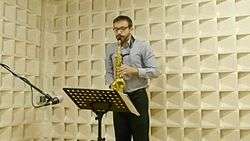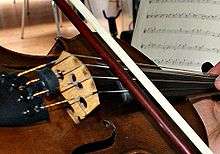Circular breathing

Circular breathing is a technique used by players of some wind instruments to produce a continuous tone without interruption. This is accomplished by breathing in through the nose while simultaneously pushing air out through the mouth using air stored in the cheeks.
History
The technique was developed independently by several cultures, and is used for many traditional wind instruments.[1]
In the 13th century, Asian metalsmiths who specialized in gold and silver used circular breathing techniques for crafting various decorative and ornamental items. In crafting such items, craftsmen were required to blow continuously to the flame through a pipe with a needle-like hole, in order to make the hard metal melt or soften. From such necessity, craftsmen mastered a circular-like cycle of breathing, simultaneously inhaling through their nose while blowing without any pauses. The introduction of the circular breathing technique in the art of ancient windplayers was a productive invention in its performing technique.[2]
Uses

It is used extensively in playing the Eastern zurna, the Mongolian limbe, the Sardinian launeddas, the Egyptian arghul, the Australian didgeridoo, as well as many traditional oboes and flutes of Asia and the Middle East. A few jazz and classical wind and brass players also use some form of circular breathing.
Although many professional wind players find circular breathing highly useful, few pieces of European orchestral music composed before the 20th century actually require its use. However, the advent of circular breathing among professional wind players has allowed for the transcription of pieces originally composed for string instruments which would be unperformable on a wind instrument without the aid of circular breathing. A notable example of this phenomenon is "Moto Perpetuo", transcribed for trumpet by Rafael Méndez from the original work for violin by Paganini.
In 1997, a Guinness World Record was set for longest held musical note. Kenny G used circular breathing to sustain an E-flat on a saxophone for 45 minutes and 47 seconds.[3] On February 2000, Vann Burchfield set a new Guinness world record for circular breathing, holding one continuous note for 47 minutes, 6 seconds, surpassing Kenny G’s record.[4] Mark Atkins on Didgeridoo Concerto (1994) plays for over 50 minutes continuously.
Method
Performing
The musician inhales fully and begins to exhale and blow. When the lungs are nearly empty, the last volume of air is blown into the mouth, and the cheeks are inflated with part of this air. Then, while still blowing this last bit of air out by squeezing the cheeks, the musician must very quickly fill the lungs by inhaling through the nose prior to running out of the air in the mouth. If done correctly, by the time the air in the mouth is nearly exhausted the musician can begin to exhale from the lungs once more, ready to repeat the process again. Essentially, circular breathing bridges the gap between exhalations with air stored in the cheeks, an extra air reserve to play with while sneaking in a breath through the nose.
Learning
The usual first difficulty is to inhale through the nose while blowing out air stored in the cheeks. To some this may be a big hurdle, to others no problem at all. One can practice this anywhere anytime by holding a finger in front of a thin air stream out of the lips and listen to the wind sound.
The next difficulty is to switch between cheek air and lung air without an unwelcome and uncontrolled jolt in the air pressure; one must learn to use the cheeks and the throat as a system of shock absorbents. A very simple method to practice this is using a thin straw to blow on the surface of a cup of water, and watch the depression that the air stream creates on the water's surface. The aim is to blow continually and switch between cheek air and lung air without any change in the depth of this depression.[5]
The traditional method of learning in zurna groups is to have one elder player lead as the chanter zurna and ask the younger players to hold the unchanging "drone tone"s. Professional zurna groups may play non-stop for as long as the party lasts, and a drone tone may be held for the whole evening.
Instruments with circular breathing integral to technique
Musicians known for circular breathing
- Lenny Pickett - American jazz multi-instrumentalist, tenor saxophonist and musical director for the Saturday Night Live Band, former member of Tower of Power
- Rahsaan Roland Kirk – jazz multi-instrumentalist[6]
- Harry Carney, baritone saxophonist and clarinetist, prominent member of the Duke Ellington Orchestra[7]
- Sonny Rollins - American jazz musician
- David S. Ware - American jazz musician
- Anthony Braxton - American saxophonist and composer[8]
- Roscoe Mitchell – jazz multi-instrumentalist[9]
- David Murray- Plays tenor saxophone and, on occasion, bass clarinet[10]
- James Carter - American jazz musician
- Theodosii Spassov - Bulgarian kaval performer and composer
- Sharon Bezaly, classical flautist[11]
- Bora Dugic - Serbian flautist and composer[12]
- Martin Fröst - Swedish clarinetist[13]
- Kenny G - American smooth jazz saxophonist[14]
- Daniel Goode – avant-garde clarinetist[15]
- Stephen Kent - didgeridoo
- Irvin Mayfield – Grammy Award-nominated jazz trumpeter, composer and cultural ambassador to New Orleans[16]
- Rafael Méndez - Mexican virtuoso solo trumpeter[17]
- Sergei Nakariakov - classical trumpeter [18]
- Evan Parker - free improvising saxophonist noted for his lengthy circular breathing excursions on soprano and tenor saxophones[19]
- Ned Rothenberg - multi-instrumentalist[20]
- Eugene Rousseau – classical saxophonist[21]
- Xavier Rudd - modern one-man band[22]
- Colin Stetson- saxophonist and multi-instrumentalist [23]
- Clark Terry - Jazz trumpet and flugelhorn player and educator. Author of Clark Terry's System of Circular Breathing (1976).
- Maynard Ferguson - Jazz trumpet and flugelhorn player and educator.
- Trombone Shorty (Troy Andrews) - Trombonist and trumpeter[24]
- Amy Dickson - Saxophonist from Australia [25]
- Jonah Parzen-Johnson - Baritone Saxophonist and composer.[26]
- Courtney Pine - Jazz Saxophonist e.g. on "Modern Day Jazz Stories" album.
- John Surman - Jazz multiinstrumentalist, mostly on saxes and clarinets, on "Cloud Line Blue" and other albums.
- John Zorn - American avant-garde composer, arranger, producer, saxophonist and multi-instrumentalist.[27]
- Wynton Marsalis – American jazz and classical trumpeter[28]
- Idrees Sulieman - Jazz Trumpeter e.g. on "Hawk Flies High" album.
References
- ↑ http://www.wisegeek.com/what-is-circular-breathing.htm Circular breathing at wisegeek
- ↑ https://www.youtube.com/watch?v=Sh73S0piXyA
- ↑ "Kenny G. Blows". Yahoo!. December 2, 1997. Archived from the original on 2012-05-17. Retrieved 2012-01-08.
- ↑ "Vann Burchfield News". NME. January 12, 2009. Retrieved 2012-12-14.
- ↑ http://www.fromnorway.net/yaylas/zurna/zurna_faq.htm#5 Zurna FAQ: How can I learn circular breathing? by Satilmis Yayla
- ↑ University of Chicago
- ↑ Laing, Dave. "Circular Breathing: The Cultural Politics Of Jazz In Britain." Popular Music History 1.2 (2006): 227-231. Academic Search Premier. Web. 17 Sept. 2012.
- ↑ Ratliff, Ben. "Music Talks to Itself and Glimpses Infinity." New York Times 11 Jan. 1997: 26. Newspaper Source Plus. Web. 17 Sept. 2012.
- ↑ "Roscoe Mitchell Interview". Perfect Sound Forever. May 1998. Retrieved 2008-06-26.
- ↑ BBC Radio 3 profile
- ↑ CD sleevenote "Barocking Together" BIS catalogue number BIS-CD-1689 released 2008
- ↑ "Bora Dugic - Zajdi, Zajdi" (in Serbian).
- ↑ Hilary, Finch. "CBSO/Gardner." The Times (United Kingdom) (2011): 13. Newspaper Source Plus. Web. 17 Sept. 2012.
- ↑ Ratliff, Ben. "Upholding the Standards Of Smooth Jazz Purists." New York Times 14 Feb. 2008: 5. Newspaper Source Plus. Web. 17 Sept. 2012.
- ↑ "Daniel Goode: About". Retrieved 2008-06-26.
- ↑ "Irvin Mayfield: Hombre of Hot Music and Vital Education". AllAboutJazz.com. 2004-08-30. Retrieved 2008-06-26.
- ↑ Applebome, Peter. "Our Towns; It's the Old Standards for a New Bayonne." New York Times 26 May 2004: 5. Newspaper Source Plus. Web. 17 Sept. 2012.
- ↑ "Sergei Nakariakov: Biography". Retrieved 2009-11-27.
- ↑ Stewart, Lee. "Evan Parker,Barry Guy,Paul Lytton." Sunday Times, The n.d.: Newspaper Source Plus. Web. 17 Sept. 2012.
- ↑ Reviewed by John, Shand. "Bend and stretch of morphing genres." Sydney Morning Herald, The 15 July 2008: 18. Newspaper Source Plus. Web. 17 Sept. 2012.
- ↑ Eugene Rousseau
- ↑ Watson, Chad. "Powered by Good Spirit." Newcastle Herald, The (includes the Central Coast Herald) 29 Oct. 2005: 22. Newspaper Source Plus. Web. 17 Sept. 2012.
- ↑ "Colin Stetson: Press". Retrieved 2010-03-25.
- ↑ Conan, Neal. "Trombone Shorty Melds Jazz Old And New." Talk Of The Nation (NPR) (n.d.): Newspaper Source Plus. Web. 17 Sept. 2012.
- ↑ "Amy Dickson - Phillip Glass' Violin Concerto No 1".
Having arranged the piece for saxophone, Amy then had to spend a further 6 months learning how to circular breath (a technique where you can both inhale and exhale air at the same time) in order to actually be able to play it!
- ↑ Reed, Bryan. "On The Beach". The Mountain Xpress. Retrieved 8 October 2012.
- ↑ Needham, Alex (13 March 2014). "John Zorn: Triple Bill review – music for listeners with a hardened palate". The Guardian. Retrieved 30 September 2014.
- ↑ Marsalis, Wynton (1995). Marsalis on Music, Volume 1 (1. ed.). New York [u.a.]: Norton. p. 134. ISBN 0393038815.
Bibliography
- Moschner.S Circular Breathing A New Approach -
- Dick R. Circular breathing for the flutist. — New York, 1987
- Dury S. Die Zikularatmung auf der Flöte. Zimmermann. Frankfurt, 1992
- Fischer J. Vom Traum der Unendlichkeit oder Versuch einer Anleitung zur Zirkularatmung für Blockflötisten // Tibia. — 1993. — Heft 1. — S. 346–35
- Katchmarschik V. Some Mysteries of Ancient Greek Aulets // Journal Internationale Double Reed Society. – 1994, July. – № 22, – Р. 93 – 99. http://www.idrs.org/publications/controlled/DR/JNL22/JNL22.Kachmarchik.html
- Katschmartschik W. Zur Geschichte und zur Entstehung der Methode des «permanenten Ausatmen» // Brass Bulletin. – 1989. – № 67. – S. 32-35.(en. ger. fr.) http://www.editions-bim.com/brass-bulletin/1986-1990/brass-bulletin-no-67-1989-international-magazine-for-brass-players.html
- Katschmartschik W. Zur Etwicklungsgeschichte der Permanentatmung // Tibia. – 1993. – Heft 1. – S. 346-351. http://www.moeck.com/cms/fileadmin/tibia/alteHefte/1993/1993-1.pdf
- Katschmartschik W. Permanent exhalation (PA) in wind instruments performing technique (problems of history and physiology). Dissert. Kiev. State Music Acad. 1995. http://cheloveknauka.com/v/68486/a?#?page=1
- Kynaston P. Trent. Circular breathing. Studio Publ. // Recordings
- Nicolet A. Studien zum Spielen Neuer Musik. Pro musica nova. — Gerig, Köln, 1973
External links
- Six Steps To Mastering Circular Breathing at Didge Project
- iDIDJ Australia: Australian Didgeridoo Cultural Hub
- Circular breathing for harmonica
- Learning circular breathing
- The Circular Breathing - Launeddas
- How to do circular breathing on saxophone
- Kenny G Circular Breathing Lesson at YouTube
- Young woman demonstrating circular breathing technique while playing didgeridoo in Carcassonne France at YouTube in HD

